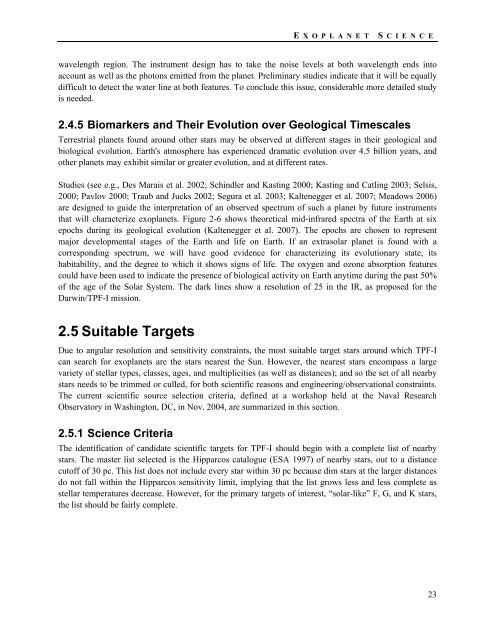TPF-I SWG Report - Exoplanet Exploration Program - NASA
TPF-I SWG Report - Exoplanet Exploration Program - NASA
TPF-I SWG Report - Exoplanet Exploration Program - NASA
Create successful ePaper yourself
Turn your PDF publications into a flip-book with our unique Google optimized e-Paper software.
E X O P L A N E T S CIENCE<br />
wavelength region. The instrument design has to take the noise levels at both wavelength ends into<br />
account as well as the photons emitted from the planet. Preliminary studies indicate that it will be equally<br />
difficult to detect the water line at both features. To conclude this issue, considerable more detailed study<br />
is needed.<br />
2.4.5 Biomarkers and Their Evolution over Geological Timescales<br />
Terrestrial planets found around other stars may be observed at different stages in their geological and<br />
biological evolution. Earth's atmosphere has experienced dramatic evolution over 4.5 billion years, and<br />
other planets may exhibit similar or greater evolution, and at different rates.<br />
Studies (see e.g., Des Marais et al. 2002; Schindler and Kasting 2000; Kasting and Catling 2003; Selsis,<br />
2000; Pavlov 2000; Traub and Jucks 2002; Segura et al. 2003; Kaltenegger et al. 2007; Meadows 2006)<br />
are designed to guide the interpretation of an observed spectrum of such a planet by future instruments<br />
that will characterize exoplanets. Figure 2-6 shows theoretical mid-infrared spectra of the Earth at six<br />
epochs during its geological evolution (Kaltenegger et al. 2007). The epochs are chosen to represent<br />
major developmental stages of the Earth and life on Earth. If an extrasolar planet is found with a<br />
corresponding spectrum, we will have good evidence for characterizing its evolutionary state, its<br />
habitability, and the degree to which it shows signs of life. The oxygen and ozone absorption features<br />
could have been used to indicate the presence of biological activity on Earth anytime during the past 50%<br />
of the age of the Solar System. The dark lines show a resolution of 25 in the IR, as proposed for the<br />
Darwin/<strong>TPF</strong>-I mission.<br />
2.5 Suitable Targets<br />
Due to angular resolution and sensitivity constraints, the most suitable target stars around which <strong>TPF</strong>-I<br />
can search for exoplanets are the stars nearest the Sun. However, the nearest stars encompass a large<br />
variety of stellar types, classes, ages, and multiplicities (as well as distances); and so the set of all nearby<br />
stars needs to be trimmed or culled, for both scientific reasons and engineering/observational constraints.<br />
The current scientific source selection criteria, defined at a workshop held at the Naval Research<br />
Observatory in Washington, DC, in Nov. 2004, are summarized in this section.<br />
2.5.1 Science Criteria<br />
The identification of candidate scientific targets for <strong>TPF</strong>-I should begin with a complete list of nearby<br />
stars. The master list selected is the Hipparcos catalogue (ESA 1997) of nearby stars, out to a distance<br />
cutoff of 30 pc. This list does not include every star within 30 pc because dim stars at the larger distances<br />
do not fall within the Hipparcos sensitivity limit, implying that the list grows less and less complete as<br />
stellar temperatures decrease. However, for the primary targets of interest, “solar-like” F, G, and K stars,<br />
the list should be fairly complete.<br />
23
















